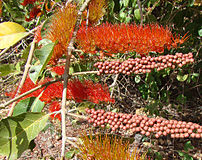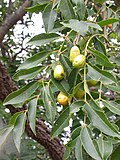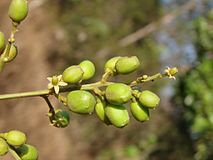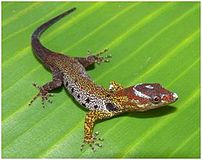Blackhead tamarin
| Blackhead tamarin | ||||||||||||
|---|---|---|---|---|---|---|---|---|---|---|---|---|

Black-headed tamarin ( Leontocebus illigeri ) |
||||||||||||
| Systematics | ||||||||||||
|
||||||||||||
| Scientific name | ||||||||||||
| Leontocebus illigeri | ||||||||||||
| ( Pucheran , 1845) |
The black- headed tamarin ( Leontocebus illigeri , syn .: Hapale illigeri , Saguinus illigeri ) is a species from the marmoset family (Callitrichidae) that occurs in northeastern Peru . The relatively small distribution area is in the Peruvian region of Loreto southwest of Iquitos and is bordered in the north by the Río Marañón , in the west by the Río Huallaga and in the east by the Río Ucayali .
features
The black-headed marin reaches a head-trunk length of about 20 cm, has a tail about 31 cm long and an average weight of 293 g. The black back hair is relatively short for a marmoset and gray and marbled reddish or ocher. The head is black and the area around the mouth and nose is gray. The outsides of the arms are maroon, the belly, legs and insides of the arms are reddish-orange. The tops of the hands and feet are blackish, often with a reddish tinge. The tail is black, the base of the tail reddish. The external genitals are black.
Habitat and way of life
The black-headed tamarin is adaptable and occurs in primary and secondary lowland rainforests, as well as in periodically flooded Várzea forests , but prefers secondary forests with dense vegetation, where it mainly lives near the ground at heights of a few meters. After the Bolivian squirrel monkey ( Saimiri boliviensis ) and the red howler monkey ( Alouatta seniculus ), they are the third most common monkey species in their area of distribution. They live in family groups made up of a dominant, solitary female, one or more males, and the pups of the last two births. The average group size is 6, the average size of the territory inhabited by a group is around 16 ha . On average, the animals are active 12 hours a day, starting with sunrise until sunset. Afternoon rain showers can end the day's activities earlier. From 8:00 to 10:00 and around noon, the monkeys usually rest. Forks of branches or a dense tangle of climbing plants in the middle or lower layers of the forest serve as sleeping places. Black-headed tamarins spend about 45% of their time looking for animal food, 15% looking for and eating plant food and about 30% resting and grooming.
Well-known predators that hunt the black-headed tamarin include various birds of prey , falcons and the marten-like tayra ( Eira barbara ).
nutrition
Combretum fruticosum is an important nectar supplier for the blackhead tamarin
The milky juice of Spondias mombin is important in the dry season
The fruits of Tapirira guianensis are mainly eaten in the middle of the rainy season
The gecko Gonatodes humeralis is one of the most preyed small vertebrates
Black-headed tamarins feed on fruits, flowers, plant juices, honey, insects and small vertebrates. Fruits are the most important food for most of the year. Almost 60 plant species have so far been identified as suppliers of food for the animals. Only in September, at the height of the dry season, tree saps become more important. An important food trees leads to aggressive interactions with food competitors such as the Cuvier ( Ramphastos tucanus ), the Braunohrarassari ( Pteroglossus castanotis ) and the Tüpfelguan ( Ortalis guttata ). The North Amazon red squirrel ( Sicurus igniventris ), on the other hand, is mostly ignored. Grasshoppers , cicadas , butterflies , moths, larvae, spiders, frogs and lizards are eaten as animal food . The animals are often captured in tree hollows or knotholes. To meet their hydration needs, they lick leaves that are wet from the rain or dunk their hands in tree hollows filled with water and then lick them off.
Reproduction
Black-headed tamarins reproduce all year round, but around 70% of the young are born between December and March (from the beginning to the middle of the rainy season) when the food supply is at its best. The interval between births is 6 to 15 months, usually 8 to 9 months.
Systematics
The black- headed tamarin was described in 1845 by the French zoologist Jacques Pucheran as Hapale illigeri , but later assigned as a subspecies to the brown-backed tamarin ( Leontocebus fuscicollis ). Today, like many other former subspecies of the brown-backed tamarin, it is an independent, monotypical species. In the vicinity of Moyobamba the black -headed tamarin hybridizes with the Andean saddleback tamarin ( L. leucogenys ).
literature
- AB Rylands & RA Mittermeier: Family Callitrichidae (Marmosets and Tamarins). P. 325 and 326 in Russell A. Mittermeier , Anthony B. Rylands & Don E. Wilson : Handbook of the Mammals of the World: Primates: 3. (2013) ISBN 978-84-96553-89-7
Web links
- Saguinus fuscicollis ssp. illigeri in the endangered Red List species the IUCN 2008. Posted by: Rylands, AB & Mitter Meier, RA, 2008. Accessed November 15, 2015.



